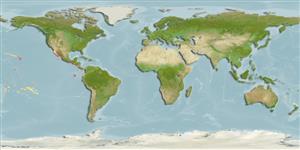Diadema mexicanum Agassiz, 1863
| Native range | All suitable habitat | Point map | Year 2050 |

|
| This map was computer-generated and has not yet been reviewed. |
| Diadema mexicanum AquaMaps Data sources: GBIF OBIS |
Google image |
No photo available for this species.
Classification / Names Common names | Synonyms | CoL | ITIS | WoRMS
Echinoidea | Diadematoida | Diadematidae
Environment: milieu / climate zone / depth range / distribution range Ecology
Benthic; depth range 0 - 104 m (Ref. 83942). Tropical
Distribution Countries | FAO areas | Ecosystems | Occurrences | Introductions
Eastern Pacific.
Length at first maturity / Size / Weight / Age
Maturity: Lm 2.5 range ? - ? cm Max length : 9.0 cm WD male/unsexed; (Ref. 128035); max. published weight: 200.00 g (Ref. 128035)
Life cycle and mating behavior Maturity | Reproduction | Spawning | Eggs | Fecundity | Larvae
Main reference
References | Coordinator | Collaborators
Alvarado, J.J. and J. Cortés 2009 Echinoderms. pp. 421-434. In I.S. Wehrtmann, J. Cortés (eds.) Marine biodiversity of Costa Rica, Central America. Springer 538 p. (Ref. 83942)
IUCN Red List Status
(Ref. 130435: Version 2025-1)
CITES status (Ref. 108899)
CMS (Ref. 116361)
Threat to humans
Human uses
| FishSource |
Tools
More information
Diet composition
Food consumption
Predators
Max. ages / sizes
Length-weight rel.
Length-length rel.
Length-frequencies
Mass conversion
Abundance
Internet sources
BHL | BOLD Systems | CISTI | DiscoverLife | FAO(Publication : search) | Fishipedia | GenBank (genome, nucleotide) | GloBI | Gomexsi | Google Books | Google Scholar | Google | PubMed | Tree of Life | Wikipedia (Go, Search) | Zoological Record


